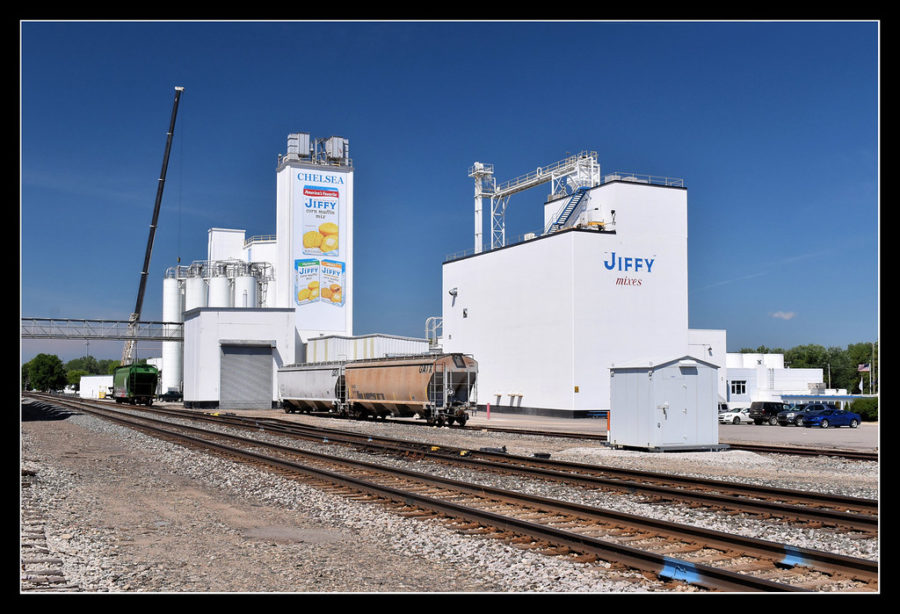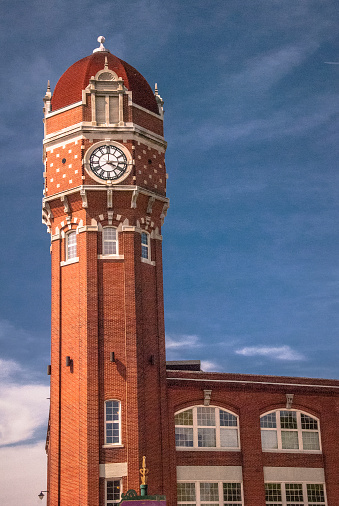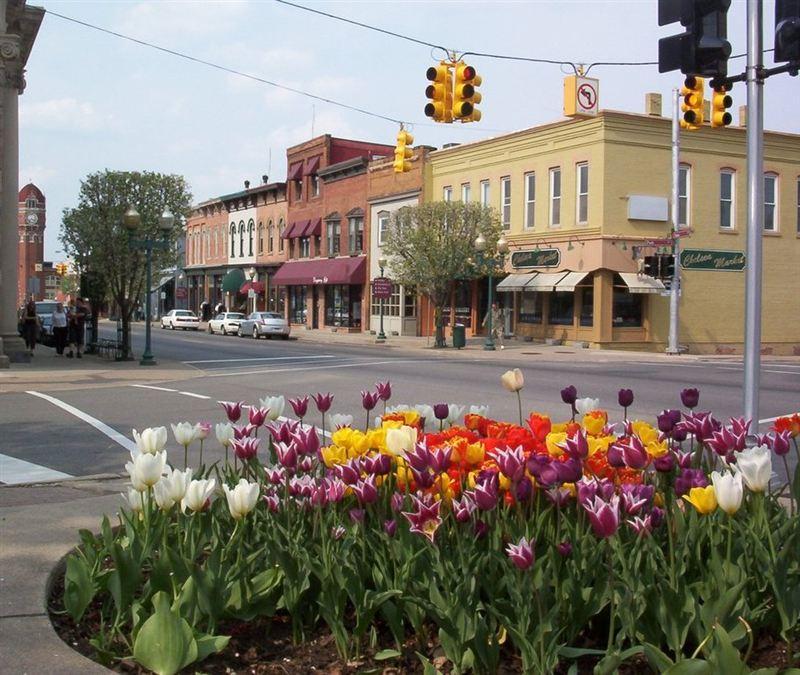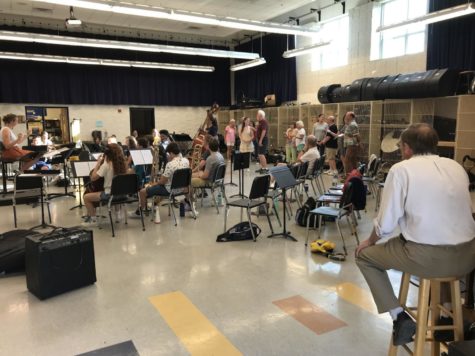History Behind Rival Towns: Chelsea vs. Dexter
Chelsea History:
Chelsea was founded in 1834 by Elisha and James Congdon and officially became a city in 2004. Brothers Nathan and Darius Pierce, who owned land south and north of downtown, were very influential in the town’s development.
The Mial M. Boyd House is home to the Chelsea Area Historical Society & Museum where one may find resources and people with information about Chelsea’s history. Founded by Elisha Congdon in 1852, the Boyed House is one of the oldest buildings in Chelsea. It was renovated in 1995 and after forty years of being a nomadic organization, the Chelsea Area Historical Society purchased it in 2014.

Chelsea is made up of many major landmarks that its citizens all recognize. The construction of these structures was influential in Chelsea’s development over time and stands as symbols of our city. Chelsea Historical Society Secretary and Board of Directors Janet Ogle-Mater was able to comment on the history behind some of these landmarks, including what we know as Jiffy.
“We know it is Jiffy because of its famous brand of muffin mixes, but it’s actually named the Chelsea Milling Company,” Ogle-Mater said. “The first mill on that property started around 1874, but it was Harmon S. Holmes’ investment in the milling company in 1898 that led to five generations of the Holmes family owning and operating it as the Chelsea Milling Company. It was his daughter-in-law, Mabel White Holmes, who created the Jiffy baking mix in her Middle Street kitchen in 1930.”
Another major landmark of Chelsea is the Clocktower which has been keeping Chelsea on time since 1907.

“The Clocktower and attached factory building [was] designed by famed Jackson architect, Claire Allen, [and] was completed in 1907 as part of the Glazier Stove Works,” Ogle-Mater said. “Frank Glazier had endured multiple devastating fires to his successful business and in preparation for another he had a 20,000-gallon water tank erected, which the Clocktower conceals. The factory building was also state-of-art in fire prevention at the time with reinforced concrete and a sprinkler system.”
The Glazier Stove Works was started in 1891 by Frank Glazier and was the first manufacturer in Chelsea. It produced oil stoves and its success led to the expansion of eighteen buildings along the railroad tracks including the Clocktower and Welfare building.
“Glazier [was] a successful businessman who built the Courthouse, which began life as a bank in memory of his father,” Ogle-Mater said. “George Glazier was Chelsea’s first banker.”
Additionally, there are many other important places in Chelsea that have shaped and grown the Chelsea community. An example of this would be the Chelsea Depot and the railroad running through the heart of town.

“The Michigan Central Railroad (MCRR) was laid through Chelsea in 1841, and the Congdon brothers offered free land to the MCRR if they’d put a depot in Chelsea,” Ogle-Mater explained. “MCRR eventually accepted the offer and built the first passenger and freight depot in Chelsea in 1850.”
The small wooden structure was replaced in 1880 with the structure that stands today after being destroyed by vandals. The connection of the railroad brought more people into Chelsea making it grow from a farming community to an industrial center.
“Of course, farming in the area continued through the 20th century, but at its peak Chelsea had large onion and wheat fields, orchards, and sheep farms,” Ogle-Mater said. “As a matter of fact, more wool shipped from Chelsea during the second half of the 19th century than any other area in Michigan.”
Chelsea’s first High School was founded in 1910 where the Schoolhouse Apartments are now. The gymnasium was added in 1926 and the school was later demolished for the Schoolhouse Apartments.
“South Meadows is now the oldest school as it was constructed in 1952 with North Creek opening in 1955,” Ogle-Mater said. “The WESC was the “new high school” from 1959-1998, until the present-day Chelsea High School opened to students in the Fall of 1998. Beach Middle School opened in 1968 and Pierce Lake Elementary was constructed in 1997, closing from school use in 2010.”
Some of the first football games held at Chelsea High School date back to 1901. Yearbooks and newspapers show us that things were certainly different then.
“Chelsea’s colors were not always Blue and Gold,” Ogle-Mater said. “A 1910 newspaper ad mentions red & white pendants to cheer on Chelsea footballers for sale; the 1923 yearbook reports buying the boys basketball team new green and white suits; and in the 1930s the color was a dark purple and gold. It seems by the 1950s the school colors were blue & gold, which they have remained.”
Dexter History:
Dexter was founded by Samuel William Dexter in 1824. He named the land after his father Samuel Dexter rather than himself. The city holds many notable places such as the Dexter Cider Mill and the Hudson Mill Metropark.
One notable location is Gordon Hall which was built in the 1840s and is home to the Dexter Area Historical Society. The Society puts on events throughout the year to raise funds for the restoration of the building. Volunteer Nancy Van Blaricum was able to comment on the history behind some of the landmarks such as Gordon Hall and the Civil War statue in Monument Park.
“[Gordon Hall] was built for Judge Dexter between the years of 1841 to 1843, [and was] named after his mother’s family,” Blaricum said. “[It was] the family home until 1899. Presidents and other notable people have visited the hall.”
Monument Park is home to Dexter’s Civil War statue and gazebo.

“The statue was placed in 1898 by the Grand Army of the Republic (GAR) to honor those Civil War Soldiers who died in the war,” Blaricum said. “Especially in the early 1900s this landmark was part of our Memorial Day Celebrations.”
Dexter’s earliest population was made up of merchants and farmers who worked to help ship goods. These people would clear trees and build homes. Sawmills were built to accommodate the settlers and allow them to access wood.
“Each home needed a well for water and of course an outhouse for bathroom needs,” Blaricum said. “The farmers needed to clear the fields of trees and bushes before they could plant crops.”
There have been many notable historical events in this area, one of them being the introduction of the railroad.
“In the 1841 [the] celebration of the coming of the railroad, President Millard Fillmore visited his brothers and sisters who lived here in the 1870s,” Blaricum said.
Dexter High School was originally built in the 1830s. When the population of students became too large, Dexter High School expanded to what it is now in 2002.
Dexter vs. Chelsea Sport Rivalry:
Both Chelsea and Dexter are a part of the Southeastern Conference, which was likely a major factor in the start of their rivalry.
“With Dexter being our closest neighbor, and apparently longest high school athletic competitor, the rivalry has only grown over the last 100-120 years,” Ogle-Mater said.
From repainting the Pierce Park rock to yelling at each other in the stands, the Dexter vs. Chelsea rivalry is very prevalent today. However, the tension that surrounds Chelsea and Dexter is something that hasn’t always been there. Chelsea Alumni Jan Bernath (‘58) shared what her experiences were like surrounding the games against Dexter.

“In the 50s, students would cheer loudly, but in a controlled manner,” Bernath said. “The student population showed support for the team by attending the games and cheering during the games–largely with the cheerleaders.”
Local businesses also showed their support when the game day was near.
“The community would mention the games at coffee shops & hairdressers, on the weekend.” Bernath said. “But signs were not in the yards of kids in sports or signs with numbers of days until game day.”
Student sections back then would still cheer and shout to show school spirit yet many things were different looking back.
“I graduated in 1958, and although there was a rivalry with Dexter, it wasn’t as prominent as it is today,” Bernath said. “In fact, it’s only about the last fifteen years that it’s so energized.”
Your donation will support the student journalists of Chelsea High School. Your contribution will allow us to purchase equipment, cover our annual website hosting costs, and write more stories for you to read!

Sonja is a junior and this is her third year writing for the Bleu Print. She is dedicated to her violin and plays in the Chelsea Orchestra program as well...





